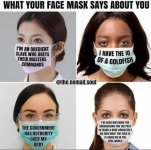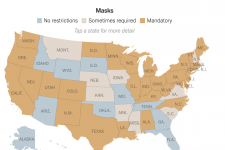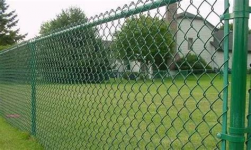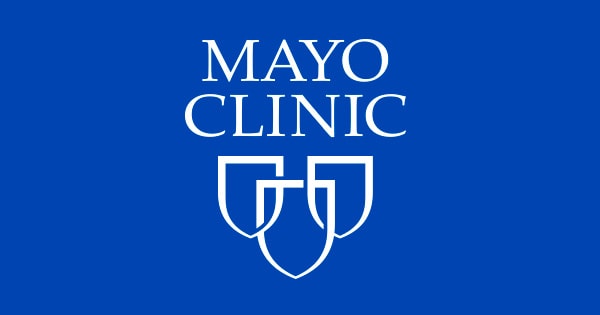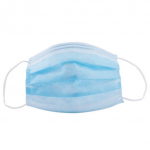You are simply wrong and are doing a great disservice by cherry-picking certain, specifc studies and drawing wild conclusions from them.
For every one-off study or article you draw on, there are 50x that say otherwise. That's why it seems you have some ulterior motive in fighting for a cause with no end game, nothing at all to gain from it. For whatever reason, you continue to choose to do so.
Face masks can help slow the spread of the coronavirus. Learn about the types of masks, which you should use and how to use them properly.

www.mayoclinic.org
Can face masks help slow the spread of the coronavirus (SARS-CoV-2) that causes COVID-19? Yes. Face masks combined with other preventive measures, such as frequent hand-washing and physical distancing, can help slow the spread of the virus.
The U.S. Centers for Disease Control and Prevention (CDC) recommends fabric masks for the general public.
We talked to UCSF epidemiologist George Rutherford, MD, and infectious disease specialist Peter Chin-Hong, MD, about the CDC’s reversal on mask-wearing, the current science on how masks work, and what to consider when choosing a mask.

www.ucsf.edu
Shifting guidelines may have sowed confusion among the public about the utility of masks. But health experts say the evidence is clear that masks can help prevent the spread of COVID-19 and that the more people wearing masks, the better.
The science around the use of masks by the public to impede COVID-19 transmission is advancing rapidly. In this narrative review, we develop an analytical framework to examine mask usage, synthesizing the relevant literature to inform multiple areas: population impact, transmission...

www.pnas.org
The preponderance of evidence indicates that mask wearing reduces transmissibility per contact by reducing transmission of infected respiratory particles in both laboratory and clinical contexts. Public mask wearing is most effective at reducing spread of the virus when compliance is high. Given the current shortages of medical masks, we recommend the adoption of public cloth mask wearing, as an effective form of source control, in conjunction with existing hygiene, distancing, and contact tracing strategies.
The science supports that face coverings are saving lives during the coronavirus pandemic, and yet the debate trundles on. How much evidence is enough?

www.nature.com
To be clear, the science supports using masks, with recent studies suggesting that they could save lives in different ways: research shows that they cut down the chances of both transmitting and catching the coronavirus, and some studies hint that masks might reduce the severity of infection if people do contract the disease.
CDC provides credible COVID-19 health information to the U.S.

www.cdc.gov
SARS-CoV-2 infection is transmitted predominately by respiratory droplets generated when people cough, sneeze, sing, talk, or breathe. CDC recommends community use of
masks, specifically non-valved multi-layer cloth masks, to prevent transmission of SARS-CoV-2. Masks are primarily intended to reduce the emission of virus-laden droplets (“source control”), which is especially relevant for asymptomatic or presymptomatic infected wearers who feel well and may be unaware of their infectiousness to others, and who are estimated to account for more than 50% of transmissions.1,2 Masks also help reduce inhalation of these droplets by the wearer (“filtration for personal protection”). The community benefit of masking for SARS-CoV-2 control is due to the combination of these effects; individual prevention benefit increases with increasing numbers of people using masks consistently and correctly.
Wearing a mask is vital to protecting others—and yourself—from COVID-19. Here’s what physicians can tell patients about picking the right face covering.
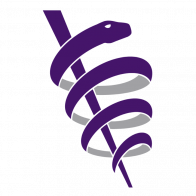
www.ama-assn.org
“The science is really clear on this—that masks are an important way that we can all slow down and prevent the spread of COVID-19,” said Preeti Malani, MD, chief health officer and professor of medicine in the infectious diseases division at the University of Michigan.
They Mayo Clinic article simply says things like "
can help slow the spread of the virus" and points to other agencies to share that you should. It even admits that masks beyond N95s are lesser in quality. No research or scientific evaluation of the effectiveness of masks with this virus.
-----
The CDC article is from last JUNE. It states "But health experts say the evidence is clear that masks
can help prevent the spread of COVID-19..." It points to studies on other diseases. It does attempt to say that in 5 areas, they noticed a drop in cases in the 5 days after mask mandates were implemented. 5 days. FIVE days. They don't name the states but I'm willing to bet 100 to 1 if we looked at those states now (not June of 2020), we'd see each of those locales saw cases skyrocket again...mitigating the value.
-----
Your PNAS article states: "
If there is strong direct evidence, either a suitably powered randomized controlled trial (RCT), or a suitably powered metaanalysis of RCTs, or a systematic review of unbiased observational studies that finds compelling evidence, then that would be sufficient for evaluating the efficacy of public mask wearing, at least in the contexts studied." Huh? This article points to wearing cloth masks in 1910 during the Manchurian Flu...as evidence.
It then goes on to discuss studies of masking with the Flu. This isn't the FLU. Further it states: "
Overall, evidence from RCTs and observational studies is informative, but not compelling on its own. Both the Australian influenza RCT and the Beijing households observational trial found around 80% efficacy among compliant subjects, and the one SARS household study of sufficient power found 70% efficacy for protecting the wearer. However, we do not know whether the results from influenza or SARS will correspond to results for SARS-CoV-2, and the single observational study of SARS-CoV-2 might not be replicated in other communities.
None of the studies looked specifically at cloth masks." Huh, what?
-----
Your Nature article (that scientific resource - from last OCTOBER) conflicts with CURRENT science, which says that the COVID virus is 60 nm to 140nm.....that's nanometers. Your article stipulates that COVID is thousands of times LARGER, measured in micrometers:
The article states (again dated information): "The virus itself is only about 0.1 µm (micrometer) in diameter." That is a MICRO METER. The difference between a nanometer and a micrometer. A nanometer is 1,000 times smaller than a micrometer.
If you mischaracterize the size of the virus, then one would assume a mask works.
The Stanford study I posted was from January 2021, and according to their study:
"According to the current knowledge, the virus SARS-CoV-2 has a diameter of 60 nm to 140 nm [nanometers (billionth of a meter)], while medical and non-medical facemasks’ thread diameter ranges from 55 µm to 440 µm [micrometers (one millionth of a meter), which is more than 1000 times larger."
That study, the most recent study including those you posted, shows....a mask is this:
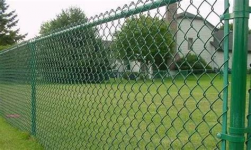
And COVID is this:

Now you run around talking about "the science" then you post a Nature.com article. I'm referencing a study done by Stanford University. I think, and call me crazy, I'll lean towards Stanford's article posted....this year.
-----
Finally your last article says (posted in December): "The use of multilayer cloth masks can block 50–70% of fine droplets and particles. They can also limit the forward spread of droplets and particles that are not captured, notes the CDC. In fact, upwards of 80% blockage has been achieved with cloth masks in some studies, which is about on par with surgical masks as barriers for source control."
Notice no mention of aerosols? Just the prevention of "droplets" and "particles." I don't argue they do that. But it's already been established that coughing into a handkerchief does the same thing.
Given the evidence COVID is passed via aerosols....well, this article too is omitting the important means by which COVID is transmitted.
You may benefit from reading the Stanford study Tibs:
"A randomized controlled trial (RCT) of 246 participants [123 (50%) symptomatic)] who were allocated to either wearing or not wearing surgical facemask, assessing viruses transmission including coronavirus
[26]. The results of this study showed that among symptomatic individuals (those with fever, cough, sore throat, runny nose ect…) there was no difference between wearing and not wearing facemask for coronavirus droplets transmission of particles of >5 µm. Among asymptomatic individuals, there was no droplets or aerosols coronavirus detected from any participant with or without the mask, suggesting that asymptomatic individuals do not transmit or infect other people
[26]. This was further supported by a study on infectivity where 445 asymptomatic individuals were exposed to asymptomatic SARS-CoV-2 carrier (been positive for SARS-CoV-2) using close contact (shared quarantine space) for a median of 4 to 5 days. The study found that none of the 445 individuals was infected with SARS-CoV-2 confirmed by real-time reverse transcription polymerase
[27].
The data suggest that both medical and non-medical facemasks are ineffective to block human-to-human transmission of viral and infectious disease such SARS-CoV-2 and COVID-19"
